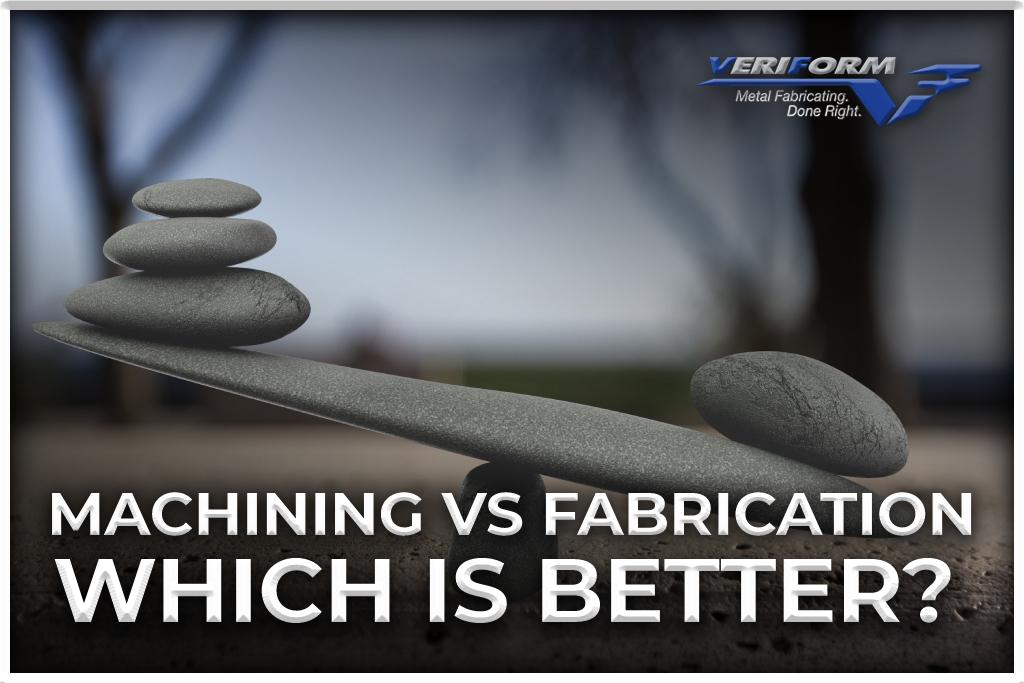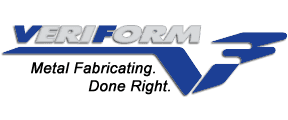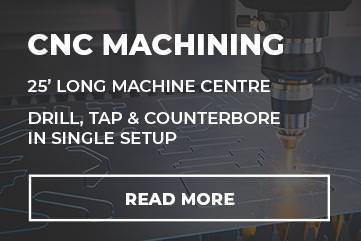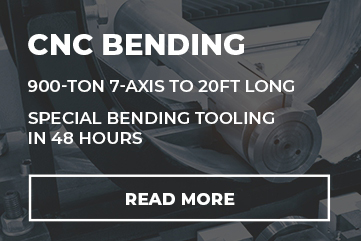News
Machining vs. Fabrication: Which is Better?

Machining and fabrication are two processes commonly used to create metal parts and components. Although a lot of machine shops and manufacturing facilities employ them to achieve comparable results, they are not the same.
At VeriForm Inc. we use both technologies to deliver client metalworking projects. In this article, we’ll go over the main differences between machining and fabrication and which one you should use for a given application.
What is Machining?
The metal machining process involves removing material from raw metals to make finished products or components. To achieve the desired shape, metal is cut, turned, drilled, or milled using a variety of machines, such as CNC machines. Our new CNC machining centre is long enough to duplicate multiple workstations, ensuring peak productivity and uptime.
Common machining technologies are highlighted in detail below.
CNC Milling
The CNC milling process, which is also known as 3D milling, involves moving the computer-directed tool across the workpiece simultaneously in three axes or more. With these machines, you can contour surfaces and drill holes with extreme precision. As a result, they are indispensable tools in the manufacturing industry.
CNC Drilling
Drilling takes place by rotating either the drill or the workpiece and feeding the drill along its axis into the workpiece. A computer-based drilling system is particularly useful for the mass production of components. With advanced and versatile CNC centres, drilling functions can be performed more quickly and on a repeatable basis.
CNC Countersinking
In countersinking, a V-shaped edge is created near the surface of the hole. It is often used for deburring holes or for making countersunk-head screws sit flush with surfaces. CNC milling commonly uses chamfering endmills to make countersinks.
Threading
Metal threading is a metal processing technique that involves making continuous helical threads on the surface of a workpiece. There are various applications for metal threading, including screws, bolts, and lead screw drives, which require high load capacity and precision in load transformation.
Different threading technologies include:
- Thread Cutting: Using tools and dies, thread cutting generates threads on the internal or external surfaces of cylinders and cones. By using a pattern-specific tool, this process removes excess material with each successive pass to achieve desired thread depth.
- Thread Milling: During thread milling, the material is removed from the workpiece’s surface with a rotating milling cutter to create threads. The internal threads are carved out by inserting a milling tool into a hole and rotating it in a circular motion. A milling tool is fed to the outer surface of the workpiece to carve out external threads.
- Tapping and Threading: In this process, threads are formed through the use of taps and dies. Taps are used to cut or form threads on the internal surface, whereas dies are used to cut threads on the external surface.
Boring
Metal boring cuts a small amount of metal from a workpiece’s inside diameter to increase the accuracy and size of a hole. The process involves rotating either the boring tool or the workpiece and slowly feeding the former along the axis of the latter.
What is Metal Fabrication?
In fabrication, raw materials such as sheet metal, textiles, and plastic are used to create objects and parts. Specifically, the machine fabrication process involves the use of certain techniques to add, remove, cast, join, or form material. The highly trained members of our parts fabrication team use the highest quality precision equipment to cut, bend and assemble complex parts of any size.
Bending
By using a brake, a sheet metal company can bend sheet metal into shapes, and channels at angles up to 120 degrees. The thinner the gauge of sheet metal, the easier it is to bend. The opposite is also possible: sheet metal manufacturers can decamber strip-shaped pieces of sheet metal to remove the horizontal bend.
Cutting
Various pieces of machinery are available for cutting sheet metal, some of which are unique to sheet metal fabrication.
- Laser Cutting: Laser cutters use powerful laser beams intensified by lenses or mirrors. They work well on thin and medium gauge sheet metal but may have trouble penetrating harder materials.
- Water Jet Cutting: This method of sheet metal fabrication uses a high-pressure stream of water (mixed with an abrasive substance) to cut through the material. Since water jet cutters do not generate heat, they are often used to fabricate parts with low melting points.
- Plasma Cutting: By creating an electrical channel of ionized gas, plasma cutters form a jet of hot plasma that can easily penetrate thick-gauge sheet metal. Although not as accurate as laser or water jet cutting machines, they are fast, powerful, and require little setup time.
Want to know the comparison of these cutting methods? Check out these articles on plasma cutting vs laser cutting and water jet cutting vs laser cutting.
Punching
When the sheet metal is placed between the two machine components, the punch forces itself through the metal to reach the die, creating holes. Punching removes circular pieces of materials, which can either be scrapped or turned into new workpieces- a process known as blanking.
Welding
With welding, heat is applied to a section of metal where it connects to another component, allowing both to be joined together. As the metal melts between the two components, it fuses to form a solid connection. Metals such as stainless steel and aluminum are comparatively easy to weld while others may require a specific welding process, such as arc, electron beam, etc.
Some metal fabricators, including Veriform Inc., also offer powder coating and assembly services for completed components.
As soon as your part is fabricated, it will need machining to knock off the rough edges or maybe a hole will need to be drilled to add a metal component. It is common for something to be machined after it has been fabricated. An example of this would be to add metal objects to a plastic part or remove flash around the edges.
VeriForm Inc.: Your Machining and Fabrication Experts
Machining and fabrication are key technologies when you’re working with sheets of metal. At VeriForm Inc., we have dedicated processes for aluminum, carbon steel, and stainless steel fabrication as well as CNC countersinking, drilling, laser cutting, and tapping. Our in-house personnel efficiencies will prepare and ship your machined and fabricated final products so you’ll have them when needed. To learn more, please visit our website, call 519-653-6000 or contact us online.








